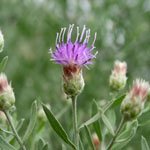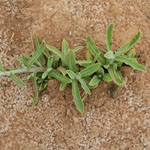Hardheads
Common name:
- Hardheads
Scientific name:
- Rhaponticum repens (L.) Hildalgo
Other scientific name:
- Acroptilon repens (L.) DC.
Other common names:
- Hardhead thistle
- Creeping knapweed
- Russian knapweed
Plant status
Catchment management authority boundaries
Regionally prohibited in the Glenelg Hopkins, Corangamite, North East, Port Phillip and Western Port catchments.
Regionally controlled in the Mallee, Wimmera, North Central, and Goulburn Broken catchments.
Restricted in the West Gippsland and East Gippsland catchments.
Plant biology
Appearance
Herbaceous plant — Forb (flowering herbaceous plant — not a grass)
Description
Hardheads are erect perennial herbs growing to a height of 30 to 90cm (mostly 45cm). Plants leave a bitter tasting substance on hands when handled.
Stems
Stems of Hardheads are erect from the centre of the rosette, stiff, branched and with a slightly woolly covering of soft grey hairs.
They are dark-brown to black underground and at the base of the plant, while silvery-grey to dull grey-green above ground.
Leaves
Leaves of hardheads are greyish or silvery-green with short hairs.
The rosette leaves grow up to 15cm long, 2-5cm wide and are lance-shaped and toothed with stalks present.
They have irregular-shaped lobes and are sparsely covered with glandular hairs. Stalks are covered in a fine down.
Stem leaves alternate along the stem and are 5 to 7cm long.
Lower stem leaves have no stalks and are slightly dissected. Upper stem leaves are progressively smaller and not divided or lobed.

Flowers
Hardheads flowers appear in heads up to 2.5cm in diameter when open. Heads are in solitary clusters on the ends of short, leafy branches.
Florets are purple, pink or occasionally white and tubular. They are surrounded by broad, thin, spineless white or pale-yellowish bracts, with a thin papery tip.
Fruit
Hardheads bear no fruit.
Seeds
Seeds are whitish or ivory and sometimes mottled. They grow 3 to 4mm long and 2 to 3mm wide and are wedge-shaped and often slightly curved.
Seeds have a pappus of numerous, stiff, barbed, white hairs which are loosely attached.
Seed heads remain tightly closed and most seed is retained within the head. Seed can remain viable for a number of years under dry conditions.
Growth and lifecycle
Method of reproduction and dispersal
Hardheads are spread mainly by the movement of root fragments through cultivation.
Segments as short as 2.5cm moved by cultivation equipment, are capable of establishing new plants wherever it is deposited.
Grazing stock may also spread the weed in paddocks by pulling stems from the ground, with the attached root segments capable of growing.
Hardheads reproduce by creeping roots and seed. Seeds may be dispersed by water (particularly along channels), contaminated farm machinery and in fodder, seed and grain.
Grazing animals are also important in dispersal as seeds can pass through the digestive tract of livestock in a viable condition and also adhere to their coats.
Seeds are not dispersed by wind.
The seed of Hardheads is largely retained in the flower head. It is relatively heavy and has a weakly attached pappus.
Rate of growth and spread
Plants usually flower in their second year of growth in late spring and summer, with aerial growth dying off again in autumn.
The weed's root system extends both laterally and vertically and the top growth dies off in autumn. Buds on the roots develop into new aerial shoots in spring and summer. The longevity of the root system enables patches of hardheads to survive adverse conditions for many years.
Seedbank propagule persistence
Seeds of Hardheads can remain viable for a number of years under dry conditions.
Preferred habitat
Hardheads prefer semi-arid to subhumid temperate regions in the 300-600 mm annual rainfall belt.
They can tolerate all soil types and drought conditions for many years because of the longevity of their extensive root system.
Growth calendar
The icons on the following table represent the times of year for flowering, seeding, germination, the dormancy period of Hardheads and also the optimum time for treatment.
| Jan | Feb | Mar | Apr | May | Jun | Jul | Aug | Sep | Oct | Nov | Dec | |
|---|---|---|---|---|---|---|---|---|---|---|---|---|
| Flowering | ||||||||||||
| Seeding | ||||||||||||
| Germination | ||||||||||||
| Dormancy | ||||||||||||
| Treatment |
Impact
Agricultural and economic impacts
Hardheads are one of the most competitive of all weeds. They can virtually exclude all other vegetation and reduce yield in dry land cropping by as much as 80 per cent.
Management
Prescribed measures for the control of noxious weeds:
- application of a registered herbicide
- physical removal.
Read about prescribed measures for the control of noxious weeds.
Other management techniques
Changes in land use practices and spread prevention may also support hardheads management after implementing the prescribed measures.